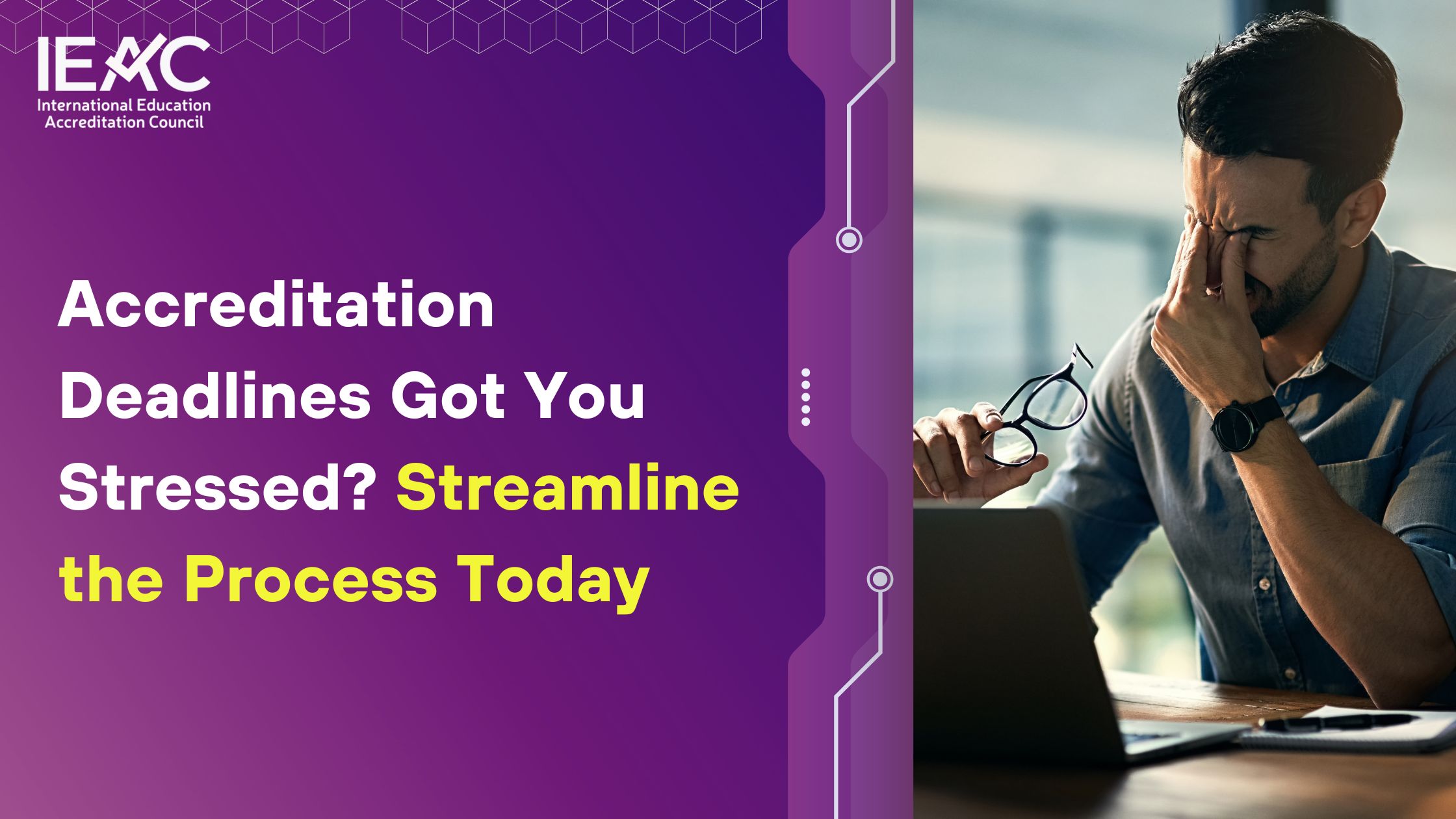- Home
- About IEAC
- Accreditation
- University Accreditation
- College Accreditation
- Online Institution Accreditation
- School Accreditation
- University Recruitment Agency Accreditation
- Programmatic Accreditation
- Teacher/ Lecturer Accreditation
- Religious Institutes Accreditation
- Affiliate Accreditation
- Research Accreditation Candidacy Accreditation
- IEAC Membership
- Institutions Accredited
- Accreditation Process
- Contact Us Webinar Apply Now
Blog
Struggling with Accreditation Deadlines? Practical Tools to Streamline Your Process
Lorem ipsum dolor sit amet, consectetur adipiscing elit, sed do eiusmod tempor incididunt ut labore et dolore magna aliqua. Quis ipsum suspendisse ultrices gravida. Risus commodo viverra maecenas accumsan lacus vel facilisis.

Struggling with Accreditation Deadlines? Practical Tools to Streamline Your Process
For many school leaders, the accreditation journey is both exciting and overwhelming. While accreditation strengthens institutional quality, governance, and global credibility, the process often comes with tight timelines, documentation challenges, and the constant pressure to keep everything aligned with standards. At IEAC, we work closely with schools worldwide and one of the most common concerns we hear is: “We’re running out of time. What do we do?”
The reality is that meeting accreditation deadlines doesn’t have to feel like a race against the clock. With the right systems, digital tools, and workflow strategies, schools can transform the accreditation cycle into an organised, predictable, and stress-free experience.
Here are practical, time-saving tools and methods that every school can use to streamline their accreditation journey.
1. Start With an Accreditation Roadmap: Your Yearly Survival Guide
Schools often struggle because the accreditation process is seen as a once-in-a-while event rather than an ongoing cycle. IEAC-accredited institutions are encouraged to build a 12-month roadmap that breaks down tasks into manageable monthly milestones.
What the roadmap should include:
- Key evidence and documents required
- Responsibilities assigned to specific staff members
- Internal review dates before the actual deadline
- Communication timelines for updates to stakeholders
- Checkpoints for policy revisions and audits
Schools using structured roadmaps report 40–50% fewer last-minute compliance issues, simply because the workload becomes predictable rather than reactive.
2. Use Digital Document Repositories to Avoid the “Can’t Find It” Problem
One of the biggest bottlenecks during accreditation is locating, updating, and verifying documents. Paper files and scattered digital folders lead to delays.
Tools that help:
- Google Workspace or Microsoft SharePoint for shared drives
- Notion, Airtable, or ClickUp for structured document management
- Version control features to keep track of the latest updates
- Access permissions for different teams
- Creating a central repository ensures that all required evidence - policies, minutes, lesson plans, student records, data dashboards, audits—is accessible and updated in real time.
Schools that transitioned to cloud document systems have reported up to 60% faster submission preparation.
3. Automate Repetitive Tasks: Let Technology Do the Heavy Lifting
School teams often spend hours manually creating:
- Review reports
- Policy summaries
- Self-evaluation forms
- Yearly audit templates
- Automation tools save enormous time.
- Recommended tools:
- AI-assisted writing tools for drafting SOPs and policies
- Workflow automators like Zapier or Power Automate
- Form builders (Google Forms, Typeform) for surveys and internal audits
- Calendar automation for reminders and task tracking
Automating data collection and report creation not only saves time but improves accuracy and consistency.
4. Build Accreditation Micro-Teams Instead of One Overloaded Committee
The biggest misconception is that one committee can handle everything. Schools that succeed with accreditation create micro-teams, each responsible for one domain such as:
- Leadership & Governance
- Teaching & Learning
- Health & Safety
- Curriculum Standards
- Student Achievement
- Community Engagement
This distributes workload, ownership, and expertise. With micro-teams, schools often experience better quality submissions and fewer deadline extensions because every domain has a dedicated lead.
5. Use Data Dashboards to Reduce Manual Reporting
Accreditation requires consistent data - attendance, assessment, teacher performance, professional development, safeguarding logs, and more.
Instead of chasing spreadsheets every quarter, schools can integrate:
- Power BI
- Google Data Studio
- Tableau Public
- Built-in dashboards within their school management system
These dashboards automatically pull live data and generate updated reports, reducing end-of-year data overload.
Schools using dashboards report a 70% reduction in time spent on evidence compilation.
6. Conduct Internal Quality Audits Twice a Year
Many schools wait until the final months to review policies, teaching practices, compliance frameworks, and risk management. This causes panic and rushed submissions.
IEAC encourages institutions to conduct biannual internal audits, focusing on:
- Alignment with standards
- Classroom observation evidence
- Policy implementation checks
- Health & safety compliance
- Staff training records
- Governance reviews
This ensures the school stays “accreditation-ready” all year round—not just during deadlines.
7. Use Communication Templates for Stakeholder Updates
Accreditation requires communication with teachers, parents, students, and governing bodies. Instead of drafting messages from scratch every time, schools can use:
- Announcement templates
- Follow-up reminders
- Meeting agendas
- Evidence request forms
A communication toolkit saves hours and maintains consistency across all departments.
8. Invest in Ongoing Professional Development for Your Accreditation Team
Teams often struggle with deadlines because they are unsure how to interpret standards or gather evidence effectively. Continuous professional development—such as workshops, short courses, or accreditation-focused training—helps teams work confidently and efficiently.
IEAC recommends regular training in:
- Policy writing
- Data-driven decision making
- Quality assurance
- Safeguarding compliance
- Curriculum alignment
- Evidence mapping
A well-trained team is the strongest tool against accreditation stress.
Conclusion: Accreditation Doesn’t Have to Be a Deadline Crisis
Accreditation is ultimately an investment in quality, not a race. With the right systems, a clear roadmap, trained micro-teams, and smart digital tools, schools can transform the process into a structured and empowering journey. By embracing these practical strategies, institutions not only meet their deadlines—they build a culture of evidence-driven excellence that lasts far beyond the accreditation cycle.
.jpg)




